Last week, we took a glance at an old fragment of goldwork and silk embroidery. As promised, we’re going to look at it a bit closer today.
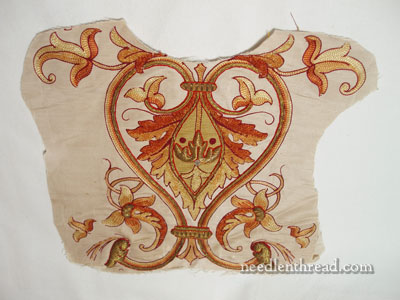
Here’s the whole fragment. The whole fragment is about 13″ wide and 10″ high. The design is obviously one of those leafy acanthus designs that have come down through the ages from Renaissance Italy. In the comments on the original post, one reader suggested the dots look like eyes, and Philippa Turnbull suggested the same thing – that it is a rendition of the Renaissance green man often seen in stonework, architecture, and art.
Whether that was the intention of the design – to look like the Renaissance green man – is not certain. The piece is definitely not that old. I’d say it’s from the first half of the 1900’s (before 1950). And I’d say that the fragment comes from a vestment. It fits perfectly an area of a typical pattern from “Roman” style vestments – the back of the vestment, just below the neck and working down towards the “transom” of the cross. There is no clue as to why it was taken apart or this fragment cut from it. My guess is that it was probably the most salvageable part of the embroidery.
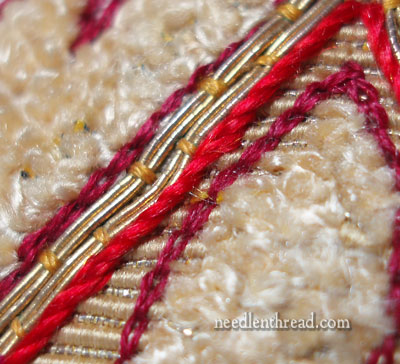
The red silk used to outline the central section of the design and the goldwork relief is worth taking a look at. This is a thicker, softly twisted red silk, very similar to Trebizond silk thread available today. The stitch used to create the outline in the red silk, from a distance, might be confusing. The red outlines are simply very long split stitches, with the split being taken right at the tip of the stitch. In some areas, they are just long straight stitches.
Because of the twist of the silk, it looks like a cord that could be couched, or, in some cases – such as its use in this photo below:
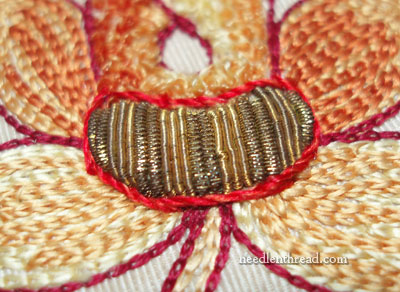
– we might be tempted to think at a glance that there’s some stem stitch or something going on here. But that isn’t the case.
This is a good example of how an outlining thread can be used, and how the outline can be worked up quite quickly on a piece like this. The disadvantage of doing so (with such long stitches) is that the stitches are less stable. The advantage of long stitches for outlining, besides the fact that longer threads work up more quickly, is that the embroiderer (passing through a couple layers of fabric and over other embroidery stitches) is not as taxed (it is hard work, working a thick thread like that with a heavier needle through layers) and the embroidery (especially those gold purls) is less likely to be marred during this final step of finishing the embroidery.
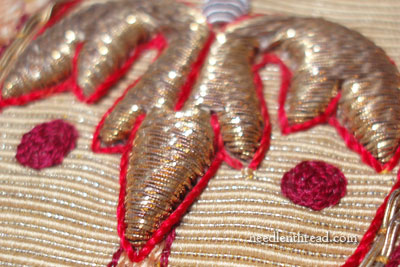
Here, you can see the red silk up close again…
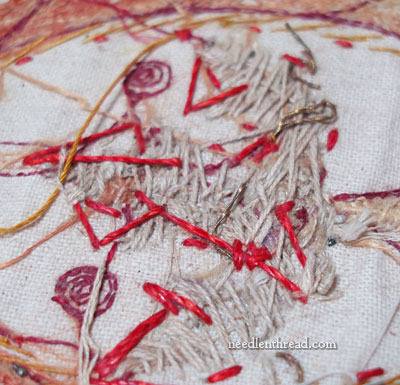
… and if you look at the back of that area, it should become more clear what’s going on, on the front of the work. Here and there you see, on the back, some little back stitches that are consistent with long split stitches, and a lot of threads crossing hither and yon.
Incidentally, The thicker white-ish thread there – it looks like cotton string (and it is) – is actually the couching thread for the gold. They used a fairly heavy cotton string for the goldwork technique. We’ll talk about that goldwork technique down the road.
But back to the silk…
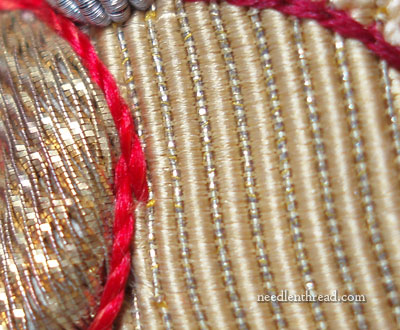
Sometimes, the stitches aren’t split.
It’s a beautiful red silk thread. I don’t particularly like it’s use in combination with the other color choices on the piece, but on vestments, I’ve often seen red used to outline goldwork elements on lighter backgrounds, to make the goldwork stand out.
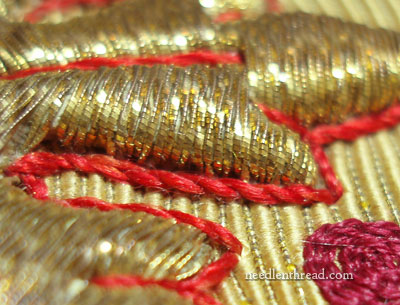
You can see a split stitch in this photo, about halfway down the length of the gold there.
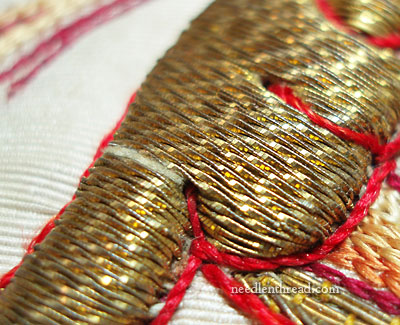
Speaking of the goldwork, above you can see where a certain level of “dissection” can take place. Splits like this excite me!
Now, don’t get me wrong! I’m not a cad, I’m not a destructive person who just wants to tear things apart to look inside them! But this particular fragment offers these little areas where we actually can access the inside without being a Major Force of Destruction.
I’m not an advocate of dismembering pieces of old embroidery – and in fact, when possible, I do my best to salvage pieces that would otherwise be disposed of or reconstructed (and usually quite poorly) into something else. But when a piece like this – which is not particularly valuable as an historical example, and which is not particularly valuable as an example of excellence in workmanship – comes along, I do use it as a piece of study, taking apart areas that already have damage to them and that are already “opened up” for exploration. We can learn from them!
In all cases, though, unless you really know what you’re doing, do get some advice before you rip into a piece of old embroidery or reconstruct it into something else!
Ok, ok. We’re not going to rip into this… we’re just going to look at it!
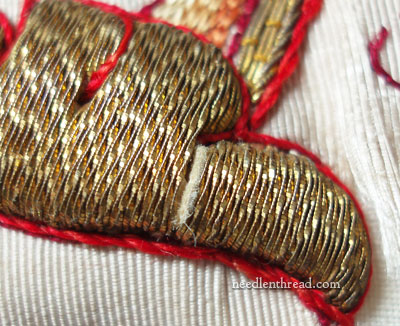
See the split? It’s there, because that particular little piece of goldwork relief was bent and the card inside broke. The threads separated enough for the edge of the card to peek out. None of the metal threads here broke. They just moved aside.
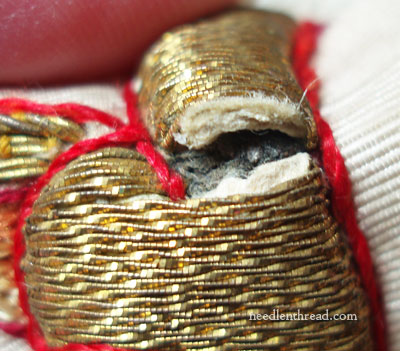
And there’s the inside!
It looks quite fuzzy, doesn’t it? Part of that is because of the close-up photography. To the naked eye, it doesn’t look this fuzzy. It looks like a peice of heavy-weight card or paper that is backed with a thin layer of dark felt. Think in terms of a pressed-paper board, that you could pull apart in layers (especially after time has passed), and you’ll have the right idea of what this stuff is like.
Goldwork in this type of relief work is found on a lot of finer, old vestments. The stuff used underneath this type of relief work varies. I’ve seen forms made from carpet-like felt covered with card, from carpet felt covered with fine yellow cotton. I’ve seen forms made from soft balsa-like wood. And I’ve seen forms made from (this is just unbelievable) stacked newspaper, pressed together and sewn into place. Literally, yes, printed newspaper.
This latter point, I’ve never understood. Why newspaper? It would be easy to say “It’s all they could afford” or all they had available, but when you’re talking about this type of goldwork (those threads have never been “cheap”!), it just boggles the mind that newspaper would have been used to pad it.
This is a technique we will look at together some day. I probably won’t use newspaper, though…
Next time, I’ll show you the inside of one of the purl areas, where the threads were broken and the purls were loose. We’ll look inside that, at the padding used there. That padding, incidentally, also helps date the piece a little bit.
If you have any questions or comments, feel free to leave them below!







Newspaper? Wow – that is a ‘different’ choice, especially considering the cost of the goldwork threads. But, maybe after purchasing the threads, there was no money left for a proper padding…? Are you able to take the layers of newspaper apart to see what they say? Another peek into the time period. All sorts of scenario’s are flitting through my head – what a clever way to ‘hide’ something they didn’t want found. Put it in goldwork! Perhaps it was an obituary of a loved one, and in this way the wearer was able to keep the loved one near. Weird I know, but people do strange things. Like I said, lots of different scenario’s flitting through my head 🙂 but I’ll quit there.
Karen
Hermosos trabajos,, yo quiero aprender a bordar de esta manera,, para relleno puedo usar cordon de algodon ??
gracias de antemano,, claudia, Chile
Mary, with your permission?
Claudia, Sí, se Purdue USAF cordón de algodón, como para crochet para el fondo o la base, abajo de Los hilos dorados. Estoy hacienda un trabajo similar agora miso y utilizo hilos de algodón para crochet, bien colchado, después, forado con Los hilos dorados. La técnica se purse ver en páginas anteriores aquí en Needlenthread. Espero que le ayude, Anne
Oops, es “se puede usar”
Ahhh!Yes,thank you for showing us the whole piece. You’re right, it IS rather unattractive….I won’t go so far as to say ugly, because there are some nice elements. But it doesn’t go together well at all…
NEWSPAPER!!? -shudder. Just knowing how the stuff degrades and the sulfur and acid content of the wood pulp – my guess is that any metal threads put over newspaper are black within just a few years. All that work for nought. Goes to show that the quality of parts that are never seen really do count – and short cuts simply short change the product.
Hi Mary
Green men gargoyles abound inside and outside churches in England and France, perhaps to scare away “the real thing” or thoughts of (as it was a pagan concept). Could the embroidered “green man-like” leaf mask and eyes on the back of the priest’s vestment been meant to scare the “green man” (or the excesses he represented) away while the priest had his back turned to the congregation?
Catherine K.
Hi, Mary, very interesting. Re the red threads, I see what you mean about the color, but does it give a different impression and emphasize the goldwork since it is a contrast and seen from a distance?
Also, re the newspaper, I wonder if they cut out multiple layers, then wet them, maybe with salt water and stuck them together. Newsprint will then dry very firm.
G’day Mary,
As Alice in Wonderland might say (but seems she never did) “It gets Interestinger and interestinger”. Seems like the embroiderer was in a hurry to get that red silk finished. Stitching along any old how so she could get to church on time! Thank you for revealing thus far, the ins and outs of this piece.
Cheers, Kath
Here is an inside perspective about the newspaper and altar linens. Rural and inner city women used what they had available to make vestments to welcome a new pastor or celebrate an ordination giving no thought to what is on the inside, as long as it is beautiful on the outside. Red is the liturgical color of the martyrs and used for depicting the fire of Pentecost so it’s the color of the day for ordinations and specific days in the church calendar. Adding a touch of red would not only show off the gold, but would also remind people of the blood of Christ and the fire of the Holy Spirit. Coordinating the red with other colors wouldn’t be seen as an issue.
Even today, churches still need vestments and altar linens, but cannot always afford what is offered in the catalogs. They find a way to make them on their own at much less expense out of light weight fabrics instead of formal ecclesiastical linens. I remember my worship professor at seminary telling us that there is nothing sacred about the fabrics we use and that many churches use what is available and have them made by local seamstresses. I have been commissioned to make sets of vestments and altar covers using basic quilting patterns or redrawn pictures. One of the mission churches I served in used paper towels as purificators because they had no way to keep linens from being ruined. As much as we all want to give our best to the Lord, even churches have budgets and real issues to work around. Church communities use what they have and the people create what they need. Many people in the early part of the 20th century would have had threads in their sewing basket to share and they probably used what they had to create the best they could offer, even if that wasn’t the prize winning vestments according to the embroidery guild. Many new young pastors are living without chasubles and only using stoles because they or their churches cannot afford to buy them. Unless embroiderers/sewists/quilters work together with altar guilds and make them many churches cannot afford to buy new or replace their ancient vestments. Studying how this is done helps us to be able to continue this tradition for our local churches, even if we don’t always do everything the way our foremothers did.
Hi Mary,
I’ve been doing raised goldwork embroidery for 20 years but on a singer machine not electrical. The hand embroidery is very different in that as you’ve commented they “stuff” either cardboard or very hard material, in alot of cases leather has been used and the results are beautiful. As for the threads they are expensive, quite heavy because they are almost metal to the touch. Alot of monasterys in Greece you will find live on this work. I would like to send you photos but I’m not sure how to do it.
Hi, Seraphima – I would love to see photos! You can email me at mary (at) needlenthread (dot) com if you like. Looking forward to seeing your work! -MC
It isn’t a green man. the pattern is upside down. 🙂 I have seen the central plant on 2 maiolica pieces with the tri leaf that you show a close up in the third picture, the way you have it in the third picture with the dots underneath and not above.
Hi Mary,
In addition of your large knowledge of gold work, you might be interested by a very old french book printed in 1761 and called “L’art du brodeur par M. de Saint Aubin”. You can down load the book for free with the following link :
http://gallica.bnf.fr/ark:/12148/bpt6k1065586m?rk=21459;2
the down load command is the descending arrow on the left column.
Of course the text is in old french and may be a little difficult but the illustrations at the end are very interesting and I can help you if you need a translation of some part of the book. In particular there is a section on cardboard padding.
Hope you’ll be interested and thank you for opening so much choices in needle work with your blog.
Bests regards
Florence Doaré
Thanks, Florence! I will explore it with enthusiasm!